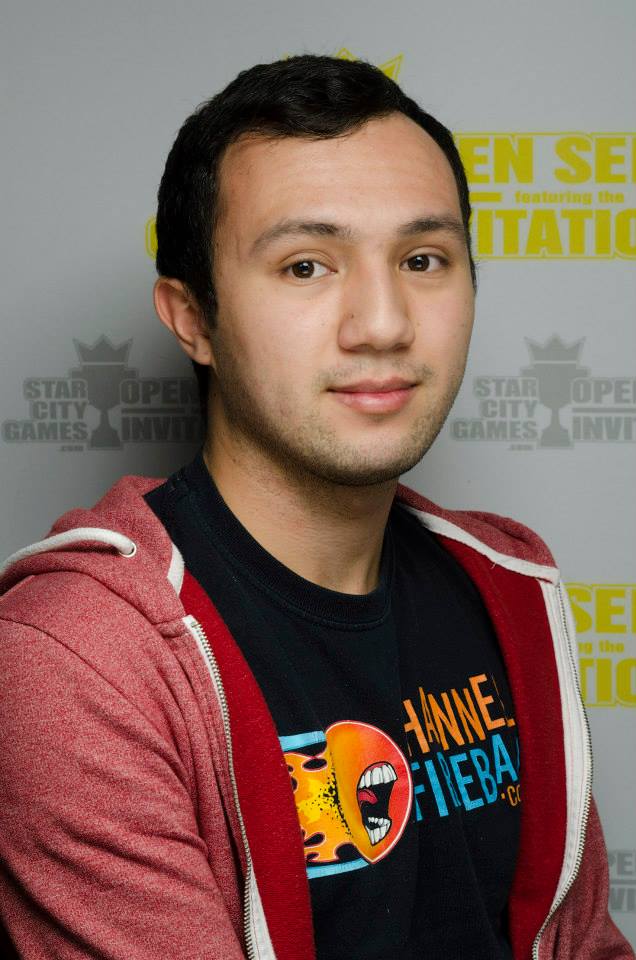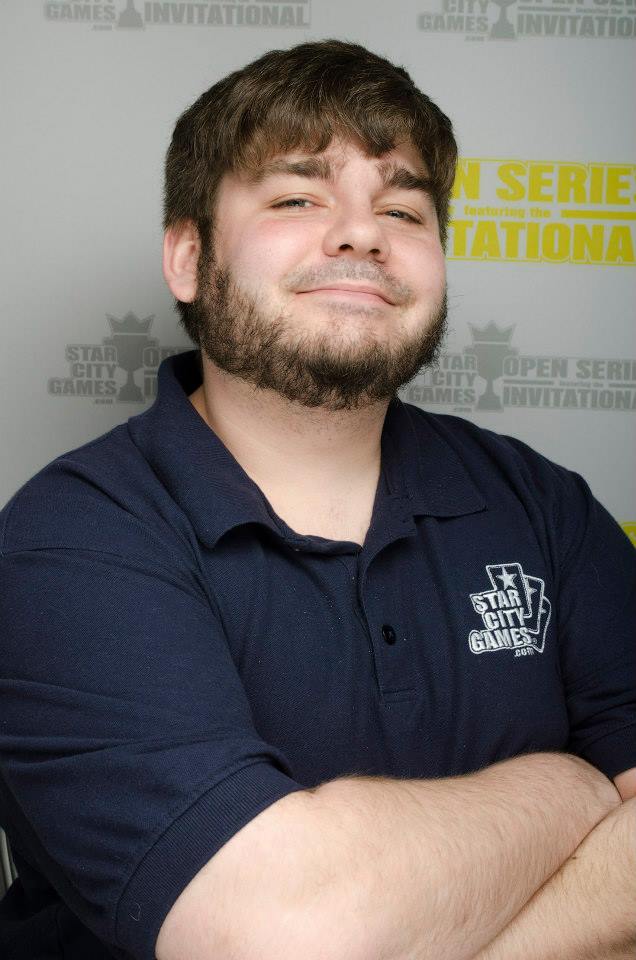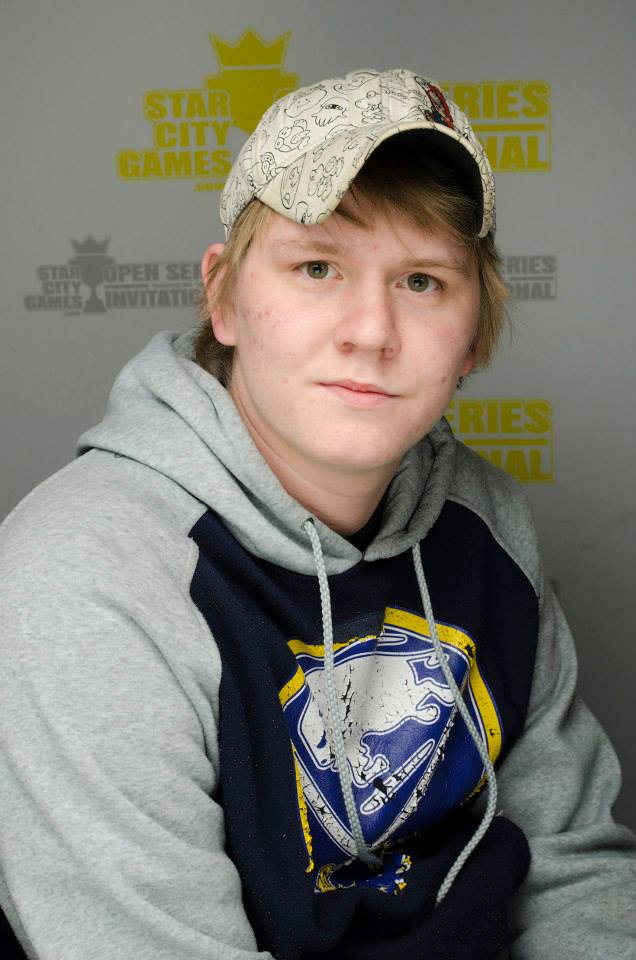Dragons of Tarkir had a huge impact on Standard.
Still, Abzan against Sultai in the finals? The more things change, the more they stay the same I guess. The entire Top 8 consisted of fairly normal decks,
but every Standard deck in the Top 8 contained cards from Dragons of Tarkir. The set may not have created new decks (at least yet), but DTK certainly
changed the dynamics of all the decks and all the matchups.
Cards like Anticipate, Dromoka’s Command, Ultimate Price, and the various aggressive red cards lived up to the hype. Thunderbreak Regent, Dragonlord
Ojutai, and to a lesser extent, Deathmist Raptor, did as well. We didn’t see many Narset Transcendents, but it didn’t appear to be a heavily played card. I
know that it was great for Shaheen Soorani in at least one match, but time will tell whether it’s a player or not.
Atarka’s Command wasn’t too popular, but it did lead to a massive blowout in Seth Manfield’s favor, which was very entertaining to watch. It also popped up
in some decks that were very similar to the Bravermans’ deck, but maybe it’s not worth the splash. After all, having to play four Mana Confluences to fix
your mana is a real cost, even in an aggressive deck.
Last week
, I made some predictions for who would make the Top 8, and I didn’t do too bad. Three of my eight were in the Top 8, and two others got 9th and 17th. Had
I known players like Korey McDuffie and Jacob Wilson were going, they would have been strong considerations as well. Joe Bass is also pretty damn good. My
Twitter predictions once the Top 8 was set were way off though.
#SCGINVI predictions:
Braverman > Andersen, Duke > Bass, Merriam > Wilson, Todd > Coleman, Braverman > Duke, Todd > Merriam, Todd
wins.
— Gerry Thompson (@G3RRYT) March 29,
2015
In a multi-format tournament, it’s important to see how each player got into the Top 8 since their place in the Top 8 isn’t necessarily an indication of
anything. Let’s start with the player that was on top of the standings for the entire tournament.
Michael Braverman

Standard: Mono-Red Aggro (8-0, 0-1 in Top 8)
Legacy: Shardless Sultai (5-1-2, both draws intentional)
Creatures (20)
- 4 Foundry Street Denizen
- 4 Eidolon of the Great Revel
- 1 Goblin Rabblemaster
- 3 Goblin Heelcutter
- 4 Lightning Berserker
- 4 Zurgo Bellstriker
Lands (21)
- 21 Mountain
Spells (19)
Sideboard

It’s certainly worth noting that Phillip Braverman went 7-1 with their Mono-Red Aggro deck as well. If you’re trying to figure out which red cards to
sleeve up, you could certainly do worse than just copying their deck. Again, the Atarka’s Commands might be worth the splash, but it isn’t free.
The token aspect is powerful with Stoke the Flames and Foundry Street Denizen. It’s also quite good when your opponent thinks you’re playing a bunch of
Goblin Rabblemasters and overvalue their spot removal. I also like the Bravermans’ sideboard plan with Outpost Siege and Hall of Triumph to fight popular
sideboard cards like Arc Lightning.
Creatures (14)
Planeswalkers (3)
Lands (22)
Spells (21)

Braverman used Shardless Sultai as his Legacy weapon, and that’s obviously a choice I can respect. His maindeck is similar to what I would play, and he
even keeps it real with no basic lands.
His sideboard Meddling Mages are the real question mark. I like being able to cascade into permanents against combo decks instead of siding in things like
Flusterstorm, but Meddling Mage’s effectiveness is still in question. Shutting down a single card rarely KOs a combo deck outright, so I don’t think it’s
worth the splash.
Jacob Wilson

Standard: Abzan Control (5-3 in swiss, 3-0 in Top 8)
Legacy: Temur Delver (8-0)
Creatures (16)
Planeswalkers (3)
Lands (24)
Spells (17)

The Sidisi, Undead Vizier engine is certainly interesting, but judging from Jacob’s 5-3 record in the swiss, I was unsure if it was actually good or not.
24 lands is dangerously low, and that seemed like something that could have potentially cost him. While Jacob and Reid both played Sidisi, Undead Vizier, I
assume that we’re just seeing the beginning stages. The coming weeks will let us know how deep people can actually go with the card.
It’s also worth noting that Jacob’s Abzan deck is a big departure away from typical Abzan Control decks. It might not become industry standard, but the
sheer fact that Abzan is customizable past the Steve Rubin version should open some doors.
Creatures (12)
Lands (18)
Spells (30)

Temur Delver did not appear to be widely played, but Jacob is very comfortable with the deck and managed to not drop a match. Very impressive.
The biggest departure from normal Temur Delver lists is that Jacob elected to play Dismember instead of the typical Chain Lightning or Forked Bolt slot.
Obviously Tarmogoyf is an issue for the deck, but there are also Tasigur, the Golden Fangs and Gurmag Anglers popping up, which are effectively black
Tarmogoyfs.
Spell Snare is an odd sideboard card and one that I would prefer to see in the maindeck, but clearly Jacob valued his Spell Pierces more. The rest of his
board looks normalized compared to the Zuran Orb and Jace, the Mind Sculptor he used to play, so that’s good. There’s only one answer to a resolved
Batterskull and zero answers to a resolved Counterbalance (unless you’re counting on Pyroblast), so the plan is to either prevent that from happening or
accept that you were likely losing those games anyway.
Look at it this way: If you’re playing a matchup where you’re a beatdown deck and they have a scary card, are you better off having something like a Krosan
Grip in your opening hand, or are you better off playing the game normally and hoping that your Spell Pierces and Dazes are enough? In the first scenario,
you have a piece of cardboard in your hand that you can’t use for anything else except for killing their scary permanent — You can’t pitch it to Force of
Will, you can’t Brainstorm it away. You’re effectively locking yourself into having a dead card until their scary card shows up.
There’s also the danger of holding Krosan Grip when your opponent stabilizes at one life. Even if their scary card shows up, does Krosan Grip-ing it mean
you win? It’s more likely that the game continues on for a bit, but you end up losing anyway. If you’d had an extra Daze, Stifle, Spell Pierce, or maybe
even a blue card, they would have ended up at negative two instead of one.
What about the times when you’re holding Krosan Grip but your opponent has a string of Swords to Plowshares into Terminus into Entreat the Angels? What
about the times when you’re holding Krosan Grip for their Batterskull, and they get to stick a True-Name Nemesis?
As it turns out, people have more than just one scary card in their deck, so over-sideboarding leaves you vulnerable to the rest of their deck. The
statement Jacob is making with his sideboard is very powerful. Generic answers like Spell Pierce and Dismember might not work every time, but it’s better
to not load up on narrow answers when your goal is ultimately trying to deal twenty damage, not contain your opponent’s threats.
Todd Anderson

Standard: Jeskai Tokens (7-1, 0-1 in Top 8)
Legacy: Infect (6-2)
Creatures (7)
Lands (24)
Spells (29)

SCG’s Jeskai Tokens deck (as played by Brad Nelson, Tom Ross, Brian Braun-Duin, and Todd Anderson) went 22-6 overall, or 78.5%. I thought it was possible
that they had the best deck in the room, and although I haven’t seen every single decklist, I still think that’s the case.
You could make an argument for the slight innovations Reid Duke and Jacob Wilson brought to the table, but with the Pro Tour in two weeks, I wouldn’t be
surprised if they weren’t bringing their best stuff. It’s early in the format, so maybe that’s not the case, but it would be incredible if it were true
considering they finished first and second regardless.
I’ve written about transformational sideboarding plenty, but it bears repeating. With the amount of information available to players, it can be difficult
to gain a significant edge in Standard when the power level is relatively flat. People are doing vastly different things, but they are roughly the same
power level, and everything is beatable. In that world, the world we currently live in, it is nearly impossible to be better than a coinflip to win any
given match.
Because of that, I’ve been trying to think of ways to gain an edge. Playskill is clearly an important aspect, but I want to do things that make it
difficult for my opponent to make the best play. For the most part, I want to avoid being linear. I don’t want to be easy to play against, easy to
sideboard against, and I want to force my opponent to make difficult decisions because they won’t always make the correct one. The easiest way I can think
of is by shifting the axis post-sideboard.
For example, Goblin Rabblemaster is an excellent Game 1 card in a deck with a bunch of removal because you should be able to clear the way, and they will
rarely have enough answers in their deck to contain it every time. After sideboard, when things like Drown in Sorrow come in, your deck should be
configured in such a way that Drown in Sorrow’s impact is significantly lessened. There is zero reason to walk into their sideboard cards.
Todd’s deck has an excellent sideboard plan involving Dragonlord Ojutai that allows him to make his opponent’s “best” sideboard cards nearly useless.
Instead of Drown in Sorrow being an all-star, it should, at best, trade straight up with a Hordeling Outburst. A hand they might keep based on the supposed
strength of Drown in Sorrow should line up poorly against your new sideboard plan.
Because of that, I think Todd could have done a little better in sideboarding for his Top 8 match. Additionally, the hand he kept in Game 5, full of Goblin
Rabblemasters and Jeskai Ascendancies, just walked right into his opponent’s sideboard cards, and he was never able to really get anything going.
Creatures (12)
Lands (20)
Spells (28)

Overall, I’d say Infect did poorly, especially considering those who were playing the deck. However, Tom Ross did finish 17th in the Invitational and 2nd
in the Legacy Premier IQ the next day. Perhaps I’m being a little harsh here, but it seems like Todd and Tom cut up the X-3 and X-4 brackets, which is to
be expected of Infect. Their Day 1 records in the X-0 and X-1 brackets was not good, which leads me to believe that the people who adequately prepared were
used to playing against Infect.
I know Todd wasn’t happy about all the weirdo one-ofs in the deck, so maybe making the deck sleeker with more Gitaxian Probes, Ponders, and perhaps Become
Immenses is the way to go. Consistency might be better than having things like Wasteland and Stifle, although I’m sure Tom Ross would disagree with me.
Reid Duke

Standard: Sultai Reanimator (7-1, 2-1 in Top 8)
Legacy: Miracles (5-1-2, one intentional draw)
Creatures (26)
- 1 Hornet Queen
- 4 Sylvan Caryatid
- 4 Courser of Kruphix
- 4 Satyr Wayfinder
- 1 Soul of Innistrad
- 1 Reclamation Sage
- 4 Sidisi, Brood Tyrant
- 1 Silumgar, the Drifting Death
- 2 Tasigur, the Golden Fang
- 1 Torrent Elemental
- 1 Dragonlord Silumgar
- 2 Sidisi, Undead Vizier
Lands (23)
Spells (11)

If you’ve been following Reid during the last year of Standard, you shouldn’t be surprised by his deck choice for the Season One Invitational. This time,
Reid brought a lot of spice, but Sidisi, Undead Vizier tends to make that happen. His deck is more threat-dense than we’ve seen, which made it look pretty
good on camera. There were very few spots where Reid didn’t have something to do with his mana.
The emphasis on Murderous Cut over Hero’s Downfall is interesting. I’ve almost always gone the opposite route for fear of control decks, but control is
always 10% or less of the metagame. Instead, Reid chose to sideboard the Hero’s Downfalls (and Sultai Charm), which is a very low-impact use of a
sideboard slot. However, if he didn’t need those sideboard slots for anything else, it’s a fine compromise. He gets the one mana goodness of Murderous Cut,
which is great in the vast majority of matchups, but he still gets to hedge after sideboard.
Planeswalkers (3)
Lands (23)
Spells (34)

There is a very short list of people I’d say should play Miracles in a tournament, and Reid is definitely at the top of that list. It’s a control deck that
is slow to play, slow to kill, and rarely takes full control of the game, so racking up unintentional draws or losing to an opponent’s string of topdecks
is a common occurrence for nearly all Miracles players.
Reid’s is more on the controlling side of nearly all Miracles decks, which is not a surprising choice for him, but it’s not something I’d recommend for
everyone. Most players would be better off using Counterbalance as a soft lock that protects something like a Vendilion Clique. It might not be quite as
rewarding as grinding your opponent into dust, but it sure makes winning the game easier.
Joe Bass

Standard: Abzan Control (7-1, 0-1 in Top 8)
Legacy: Miracles (5-1-2, one intentional draw)
Creatures (10)
Planeswalkers (4)
Lands (26)
Spells (20)

For those that know Joe, it might be surprising to see him playing a midrange deck, but as he put it, his deck is firmly a control deck. Courser of Kruphix
and Siege Rhino might be creatures, but they help prolong the game and are virtual removal spells against ground creatures because they can block. Joe is a
control player at heart, but he also knows when to turn the corner, so Abzan, especially this version, isn’t outside his range.
Ultimately, I think he could have won his match against Reid had he been well-versed in the matchup, but he made some missteps and Reid played great, as
always.
Creatures (4)
Planeswalkers (3)
Lands (22)
Spells (31)

Joe has been playing “Bass Blade” for quite some time and basically always puts up a solid result. It’s a true testament to playing what you know as
opposed to what other people is say is “better.” His version is certainly weaker in some regards, but Stoneforge Mystic gives him the clock that he’s
looking for.
Jason Coleman

Standard: Abzan Aggro (6-2, 1-1 in Top 8)
Legacy: Lands (6-1-1, one intentional draw)
Creatures (20)
- 4 Fleecemane Lion
- 3 Anafenza, the Foremost
- 2 Wingmate Roc
- 4 Rakshasa Deathdealer
- 4 Siege Rhino
- 1 Whisperwood Elemental
- 2 Tasigur, the Golden Fang
Planeswalkers (2)
Lands (25)
Spells (13)

Jason was clearly the unknown entity in the Top 8, and he made it with a deck that many have written off in the past — Abzan Aggro. His deck choice was
very popular in the Standard Open, so clearly it’s not quite dead. As people shift away from Abzan Control in favor of shiny new cards, Abzan Aggro gets
even better. While the camps seem split between Andrew Boswell’s lower to the ground version and Coleman’s more traditional version, it’s clear that you’ll
have to be prepared for it.
Lands (34)
Spells (26)

Lands is a great choice for Invitationals. The proliferation of fair decks gives Lands plenty of favorable matchups. You just need a plan for decks like
Storm and Miracles. I’ll likely be revisiting this archetype in the future, especially since it continues to overperform.
Ross Merriam

Standard: G/R Aggro (5-3, 0-1 in Top 8)
Legacy: Sultai Delver (7-0-1, one intentional draw)
Creatures (30)
- 4 Elvish Mystic
- 4 Stormbreath Dragon
- 4 Boon Satyr
- 4 Goblin Rabblemaster
- 4 Rattleclaw Mystic
- 3 Heir of the Wilds
- 4 Thunderbreak Regent
- 3 Surrak, the Hunt Caller
Lands (23)
Spells (7)
Sideboard

Ross Merriam appears to be on quite the tear. He faltered a bit during the Standard portion, and his draws in the Top 8 weren’t exactly great, but he did
get to notch another Top 8 thanks to Elvish Mystic. His G/R Aggro deck appears to be rather strong, with several similar decks showing up in the Standard
Open Top 8.
The biggest question mark is Goblin Rabblemaster. AJ Kerrigan wanted his version of the deck to only have creatures that attacked through Siege Rhino, so
he included things like Deathmist Raptor in that spot instead. Rabblemaster did not look great in this deck on camera for several reasons. It died easily,
wasn’t good on defense, and there wasn’t enough removal to push it through. Obviously Turn 1 Elvish Mystic into Turn 2 Goblin Rabblemaster is a beating,
but so is any other three-drop in that spot. Deathmist Raptor might not be quite as punishing, but it will mostly get the job done.
Creatures (13)
Planeswalkers (2)
Lands (20)
Spells (25)

I’m still not convinced that Sultai Delver isn’t a worse Shardless Sultai or Temur Delver deck. I won’t extrapolate on that point too much because I feel
like it’s an article in itself, but the Sultai cards are very reactive, and the Temur cards are not. Things like Abrupt Decay and Hymn to Tourach naturally
draw out the game, at which point your tempo cards are no longer very good. I’d rather have Stifle and Lightning Bolt.
That said, I predicted Sultai Delver would be a popular choice, and it was, although only one of them made the Top 8. Jacob Wilson’s run with Temur Delver
was inspiring and should bring back a mini-resurgence of Temur.
Obviously Ross’ 7-0-1 run with Sultai Delver was pretty nice too, but it just doesn’t command the same oomph that an 8-0 record does, especially since
Jacob won the tournament.
Chris Andersen

Standard: G/W Devotion (7-1, 1-1 in Top 8)
Legacy: Esper Thopters (5-2-1, one intentional draw)
Creatures (30)
- 4 Elvish Mystic
- 3 Polukranos, World Eater
- 4 Sylvan Caryatid
- 3 Voyaging Satyr
- 4 Courser of Kruphix
- 3 Genesis Hydra
- 4 Whisperwood Elemental
- 1 Temur Sabertooth
- 4 Deathmist Raptor
Lands (24)
Spells (6)

For better or worse, G/W Devotion is still alive. I feel a bit better knowing that the format appears to have opened up a bit, so the risk of a G/W
Devotion mirror is less likely. With Deathmist Raptor, G/W is focusing less on stalling the game out by gaining 400 life and is trying to function as a
normal deck. That’s a boon for tournament players and viewers, and it also gives the deck a helpful new dimension.
Creatures (5)
Lands (19)
Spells (36)

Perhaps with his finish, Chris will make people respect Thopter Foundry. He already finished in the Top 16 of an Open with it, but I’ve seen virtually
nobody talk about it or show any interest in playing the deck. Perhaps our editor could convince young Christoffer to write about it? [CEDitor’s Note: I’ll see what I can do Gerald.]
And The Rest
I think most people put a little too much stock in the Top 8 decks, even though there’s plenty of information to be gleaned from the rest of the
tournament. Once you look at the big picture, everything becomes a little clearer. For example, Todd Anderson’s Jeskai Tokens deck looks great, but he lost
in the Top 8. Not exciting, right?
Well, what about when you consider that Brian Braun-Duin finished 9th with roughly the same Standard deck? If the same deck put two copies in the Top 8,
you’d probably look a little harder at the archetype. All told, a second copy in 9th place is close enough in my opinion.
On the other side of the room, there was a Standard Open taking place. The Top 8 of that tournament was seven aggro decks and G/W Devotion, so the winner’s
circle was mono-creatures. The rest of the Top 64 was very diverse, although not much stood out to me in the way of innovation.
This is probably the most interesting deck to come out of the Top 64 Open decklists:
Creatures (16)
- 1 Hornet Queen
- 4 Sylvan Caryatid
- 3 Courser of Kruphix
- 2 Soul of Theros
- 4 Dragonlord Atarka
- 2 Dragonlord Dromoka
Planeswalkers (5)
Lands (24)
Spells (15)

Explosive Vegetation is a helluva Magic card, but is it really better than Frontier Siege? For Naya, the mana fixing aspect is valuable, especially once
you’re playing things like Anger of the Gods and Elspeth, Sun’s Champion.
This deck looks a little rough, but this is the first proven strategy that is focused on ramping to Dragonlord Atarka, and this deck doesn’t mess around.
The full four Atarkas are present, as are a bunch of other high impact, high-casting cost threats. This deck has got to be a ton of fun, and I’m sure there
are plenty of variations to find.
Going Forward
To the surprise of no one, the Legacy Premier IQ Top 8 at the Invitational was seven decks with Brainstorm. The decks were slightly different than what
we’re used to seeing, but the format looks roughly the same. That is to say the format looks fun, and I can’t wait to play it in a big tournament. I’m just
not sure when that will be.
As for Standard, I’ll be hitting it hard after the Pro Tour.
